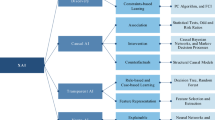Abstract
Predicting and preparing for the unforeseen is challenging. Medicine and health care are continuously changing based on science, technology, and regulation. This very process of change creates pathways for surprise and leaves us vulnerable to its impact. The armed forces have established strategies to identify and address surprising events, a framework that can be adapted to benefit the medical community. We introduce Medical Surprise Anticipation and Recognition Capability (SARC), adapted from an established military strategy. SARC is the process of addressing surprising events before they emerge. We explore the framework for mitigating surprise as developed by the Committee on Capability Surprise on U.S. Naval Forces. We recommend further exploration of this concept in health care as a potential asset in our quest towards high reliability.
Similar content being viewed by others
References
Federation of Medical Regulatory Authorities of Canada. Federation of State Medical Boards. Medical Regulatory Authorities and the Quality of Medical Services in Canada and the United States [Internet]. New York, NY: Milbank Memorial Fund; 2008 [cited 2019 Apr 2]. Available from: https://www.milbank.org/wp-content/files/documents/0806MedServicesCanada/0806MedServicesCanada.pdf
Field RI. Why is health care regulation so complex? P T. 2008 Oct;33(10):607–8.
Institute of Medicine. The Future of Nursing: Leading Change, Advancing Health [Internet]. Washington, DC: The National Academies Press; 2011. Available from:. https://doi.org/10.17226/12956.
Laurencin C, Nair L. Next Generation Devices and Technologies Through Regenerative Engineering. In: Shorey R, Purnendu G, editors. Healthcare Engineering: Proceedings of CAETS 2015 Convocation on Pathways to Sustainability. Singapore: Springer Nature; 2017. p. 21–8.
McGrory K, Bedi N. HeartBroken [Internet]. Tampa Bay Times. 2018 [cited 2019 Jul 17]. Available from: https://www.tampabay.com/projects/2018/investigations/heartbroken/all-childrens-heart-institute/
McGrory K, Bedi N. Top All Children’s executives resign following Times report on heart surgeries [Internet]. Tampa Bay Times. 2018 [cited 2019 Jul 17]. Available from: https://www.tampabay.com/investigations/2018/12/11/top-all-childrens-executives-resign-following-times-report/
Bedi N, McGrory K. Regulators still not satisfied with All Children’s progress [Internet]. Tampa Bay Times. 2019 [cited 2019 Jul 17]. Available from: https://www.tampabay.com/investigations/2019/05/01/regulators-still-not-satisfied-with-all-childrens-progress/
McGrory K, Koh E. Lawmakers approve measure to catch pediatric heart surgery problems [Internet]. Tampa Bay Times. 2019 [cited 2019 Jul 17]. Available from: https://www.tampabay.com/florida-politics/buzz/2019/04/29/lawmakers-approve-measure-to-catch-pediatric-heart-surgery-problems/
McGrory K, Bedi N. Extra oversight for children’s heart surgery signed into law [Internet]. Tampa Bay Times. 2019 [cited 2019 Jul 17]. Available from: https://www.tampabay.com/investigations/2019/06/26/extra-oversight-for-childrens-heart-surgery-signed-into-law/
Reason J. Human error: models and management. BMJ. 2000;320:768–70.
Institute of Medicine. To Err is Human: Building a Safer Health System [Internet]. Washington: The National Academies Press; 2000. Available from. https://doi.org/10.17226/9728.
Reason J. Managing the Risk of Organizational Accidents. Burlington: Ashgate; 1997.
Chassin MR, Loeb JM. High-Reliability Health Care: Getting There from Here. MilBank Q. 2013;91(3):459–90.
Rochlin GI. Reliable Organizations: Present Research and Future Directions. J Conting Cris Manag. 1996;4(2):55–9.
Roberts KH. New challenges in organizational research: high reliability organizations. Ind Cris Quaterly. 1989;3:111–25.
Weick K, Sutcliffe K. Managing the Unexpected. 2nd ed. San Francisco: Josey-Bass; 2007.
Hughes RG. Tools and Strategies for Quality Improvement and Patient Safety [Internet]. Hughes R, editor. Patient Safety and Quality: An Evidence-Based Handbook for Nurses. Rockville (MD): Agency for Healthcare Research and Quality (US); 2008 [cited 2019 Apr 2]. p. ch. 44. Available from: https://www.ncbi.nlm.nih.gov/books/NBK2682/
Carthey J, De Leval MR, Reason JT. Institutional resilience in healthcare systems. Qual Heal Care. 2001;10:29–32.
Defense Science Board. Report of the Defense Science Board 2008 Summer Study on Capability Surprise Volume I: Main Report [Internet]. Washington, DC; 2009 [cited 2019 Mar 7]. Available from: https://www.acq.osd.mil/dsb/reports/2000s/ADA506396.pdf
Mills C, Goon P. PAK-FA, F-35, F-22, and Capability Surprise [Internet]. 2010 [cited 2019 Apr 10]. Available from: http://www.ausairpower.net/APA-NOTAM-230210-1.html
Cancian MF. Coping with Surprise in Great Power Conflicts [Internet]. Center for Strategic and International Studies; 2018 [cited 2019 Apr 10]. Available from: https://csisprod.s3.amazonaws.com/s3fspublic/publication/180227_Cancian_CopingWithSurprise_wAppen_Web.pdf
National Research Council. Responding to Capability Surprise : A Strategy for U.S. Naval Forces [Internet]. Washington: The National Academies Press; 2013. Available from:. https://doi.org/10.17226/14672.
Vincent C, Amalberti R. Safer healthcare: Strategies for the real world. Cham: Springer; 2016.
Harris HR. Howard’s legendary LaSalle Leffall still going strong at 85 [Internet]. The Washington Post. 2015 [cited 2019 Jul 24]. Available from: https://www.washingtonpost.com/news/local/wp/2015/05/19/howards-legendary-dr-lasalle-leffall-still-going-strong-at-85/
Kardos M, Dexter P. A Simple Handbook for Non-Traditional Red Teaming [Internet]. Joint and Operations Analysis Division; 2017 [cited 2019 Mar 7]. Available from: https://apps.dtic.mil/dtic/tr/fulltext/u2/1027344.pdf
Mayberry RM, Nicewander DA, Qin H, Ballard DJ. Improving quality and reducing inequities: a challenge in achieving best care. Proc (Baylor Univ Med Cent). 2006;19(2):103–18.
Institute of Medicine. Crossing the Quality Chasm: A New Health System for the 21st Century [Internet]. Washington: The National Academies Press; 2001. Available from:. https://doi.org/10.17226/10027.
Author information
Authors and Affiliations
Corresponding author
Ethics declarations
Conflict of Interest
The authors declare that they have no conflict of interest.
Ethical Approval
This article does not contain any studies with human participants or animals performed by any of the authors.
Informed Consent
Not applicable.
Funding
This study was supported by NIH Grant DP109349.
Additional information
Publisher’s Note
Springer Nature remains neutral with regard to jurisdictional claims in published maps and institutional affiliations.
Rights and permissions
About this article
Cite this article
Laurencin, C.T., McClinton, A. Medical Surprise Anticipation and Recognition Capability: A New Concept for Better Health Care. J. Racial and Ethnic Health Disparities 6, 869–873 (2019). https://doi.org/10.1007/s40615-019-00626-4
Received:
Revised:
Accepted:
Published:
Issue Date:
DOI: https://doi.org/10.1007/s40615-019-00626-4




